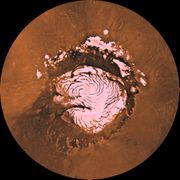 |
|
|
|
Tue, 14 Oct, 2025
|

|
|

Pay as you go
No monthly charges. Access for the price of a phone call
Go>
Unmetered
Flat rate dialup access from only £4.99 a month Go>
Broadband
Surf faster from just £13.99 a month Go> |
Save Even More
Combine your phone and internet, and save on your phone calls
More Info> |
This weeks hot offer
 24: Series 5
24: Series 5
In association with Amazon.co.uk £26.97 |
|
A polar ice cap is a high- latitude region of a planet or moon that is covered in ice. This term is somewhat of a misnomer since an ice cap is less than 50,000 km² and is always over land. Polar ice caps do not have size, composition or geologic requirements of being over land, but they must be centered in the polar region.The composition of the ice will vary. Earth's polar ice caps are mainly water ice, while Mars's polar ice caps are a mixture of carbon dioxide ice and water ice.Polar ice caps form because high- latitude regions receive less energy in the form of solar radiation from the sun than equatorial regions, resulting in lower surface temperatures. Seasonal variations of the ice caps will take place due to varied solar energy absorption as the planet or moon revolves around the sun. Additionally, in geologic time scale, the ice caps may grow or shrink due to climate variation. See ice age, polar climate.
 Earth - Contents Earth - Contents
 Earth as seen from Apollo 17, with southern polar ice cap visible (Courtesy NASA)
Earth's north pole is covered by floating pack ice (sea ice) over the Arctic Ocean. Portions of the ice that don't melt seasonally can get very thick, up to 3–4 meters thick over large areas, with ridges up to 20 meters thick. One-year ice is usually about a meter thick. The area covered by sea ice ranges between 9 and 12 million km².Earth's south pole, in Antarctica, is covered by the Antarctic ice sheet. It covers an area of almost 14 million km² and contains 30 million km³ of ice. Around 90% of the fresh water on the Earth's surface is held in this ice sheet. In addition, the West Antarctic Ice Sheet covers 3.2 million km² and the Ross Ice Shelf covers 0.5 million km². See Climate of Antarctica.
 Mars - Contents Mars - Contents
 Mars's north polar region with ice cap, composite of Viking 1 orbiter images (Courtesy NASA/ JPL-Caltech)
The planet Mars also has polar ice caps, but they consist of frozen carbon dioxide as well as water. The ice caps change with the Martian seasons-the carbon dioxide ice sublimates in summer, uncovering a surface of layered rocks, and forms again in winter.
|
Change Text Size:
[A]
[default]
[A] |




 |
|
|
|
|